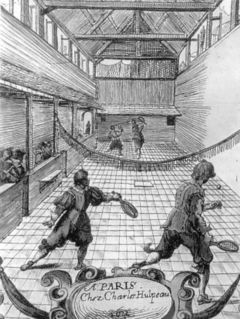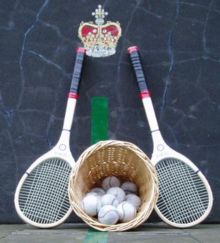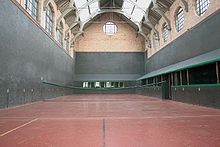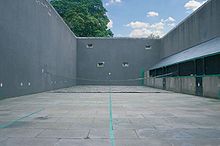
Real tennis
Background Information
This content from Wikipedia has been selected by SOS Children for suitability in schools around the world. Sponsoring children helps children in the developing world to learn too.
Real tennis is the original racquet sport from which the modern game of lawn tennis, or tennis, is descended. It is also known as jeu de paume in France, "court tennis" in the United States, and "royal tennis" in Australia.
The term "real" may be a corruption of "royal" and related to the game's connection with royalty during its heyday in England and France in the 16th and 17th centuries. Others believe that "real" was first used at the end of the 19th century as a retronym to distinguish it from the then recently invented game of lawn tennis. Real tennis players often just call the game "tennis", describing the modern game as "lawn tennis".
Real tennis is still played by enthusiasts on about 35 existing courts in the United Kingdom, Australia, the United States, and France. The sport is supported and governed by organizations around the world.
History
The term "tennis" derives from the French word tenez, which means "take heed" — a warning from the server to the receiver. Real tennis evolved over three centuries from an earlier ball game played around the 12th century in France. This had some similarities to palla, fives, pelota, or handball, involving hitting a ball with a bare hand and later with a glove. One theory is that this game was played by monks in monastery cloisters, based on the construction and appearance of early courts. By the 16th century, the glove had become a racquet, the game had moved to an enclosed playing area, and the rules had stabilized. Real tennis spread across Europe, with the Papal Legate reporting in 1596 that there were 250 courts in Paris alone, near the peak of its popularity in France
Royal interest in England began with Henry V (1413-22) but it was Henry VIII (1509-47) who made the biggest impact as a young monarch, playing the game with gusto at Hampton Court on a court he had built in 1530, and on several other courts in his palaces. It is believed that his second wife Anne Boleyn was watching a game of real tennis when she was arrested and that Henry was playing tennis when news was brought to him of her execution. During the reign of James I (1603-25), there were 14 courts in London.
In France, François I (1515-47) was an enthusiastic player and promoter of real tennis, building courts and encouraging play among the courtiers and commoners. His successor, Henry II (1547-59) was also an excellent player and continued the royal French tradition. During his reign, the first known book about tennis, Trattato del Giuoco della Palla was written in 1555 by an Italian priest, Antonio Scaino da Salo. Two French kings died from tennis-related episodes--Louis X of a severe chill after playing and Charles VIII after being struck with a ball. King Charles IX granted a constitution to the Corporation of Tennis Professionals in 1571, creating the first pro tennis 'tour', establishing three levels of professionals-- apprentice, associate, and master. The first codification of the rules of real tennis was written by a professional named Forbet and published in 1599.
The game thrived among the 17th century nobility in France, Spain, Italy and in the Austro-Hungarian Empire, but suffered under English Puritanism. By the Age of Napoleon the royal families of Europe were besieged and real tennis was largely abandoned. Real tennis played a minor role in the history of the French Revolution, through the Tennis Court Oath, a pledge signed by French deputies in a real tennis court, which formed a decisive early step in starting the revolution. In England, during the 18th century and early 19th century as real tennis died out, two other racquet sports emerged, racquets and squash racquets.
In Victorian England real tennis had a revival but broad public interest shifted to the outdoor game of lawn tennis which quickly became the most popular form of the sport. Real tennis courts were built in Australia (1882) and in the United States starting in 1876 in Boston, followed by New York in 1890, and also at a few other athletic clubs. Real tennis also influenced the game of stické, which was also invented in the 19th century and combined aspects of real tennis, lawn tennis and racquets.
Manner of play
The rules and scoring are similar to those of lawn tennis, which derives from real tennis. Although in both sports game scoring is by fifteens (with the exception of 40, which was shortened from forty-five)), in real tennis six games wins a set, even if the opponent has five games. A match is typically best of five sets.
The 2½ inch (64 mm) diameter balls are handmade and consist of a core made of cork with fabric tape tightly wound around it and covered with a hand-sewn layer of heavy woven woolen cloth, traditionally "Melton" cloth (not felt which is unwoven and not strong enough to last as a ball covering). Until recently the balls were always white, but "optic yellow" has been introduced for improved visibility, as was done years earlier in lawn tennis. The balls are much less bouncy than a lawn tennis ball, and weigh about 2½ ounces (71 grams) (lawn tennis balls typically weigh 2 ounces). The 27 inch (686 mm) long racquets are made of wood and use very tight strings to cope with the heavy ball. The racquet head is bent slightly to make it easier to strike balls close to the floor or in corners.
A real tennis court (jeu à dedans) is a very substantial building (a larger area than a lawn tennis court, with walls and a ceiling to contain all but the highest lob shots). It is enclosed by walls on all sides, three of which have sloping roofs (known as "penthouses") with various openings, and a buttress ( tambour) off which shots may be played. The courts (except at Falkland Palace, a jeu quarré design) share the same basic layout but have slightly different dimensions. The courts are about 110 by 39 feet (33.5 × 11.9 m) including the penthouses, or about 96 by 32 feet (29.3 × 9.8 m) on the playing floor, varying by a foot or two per court. They are doubly asymmetric— not only is one end of the court different in the shape from the other, but the left and right sides of the court are also different.
The service happens from only one end of the court (the "service" end) and the ball must touch the penthouse above and to the left of the server once before touching the floor in the "hazard" (receiving) end of the court. There are numerous and widely differing styles of service, many with exotic names to distinguish them, such as "railroad", "bobble", "poop", "pique", "boomerang" and "giraffe".
The game has other complexities, including that when the ball bounces twice at the serving end the serving player does not generally lose the point outright. Instead a "chase" is called and the server gets the chance, later in the game currently being played, to replay the point from the other end, but under the obligation of ensuring every shot he plays has a second bounce further back from the net than the shot he failed to reach. A chase can also be called at the receiving ("hazard") end, but only on the half of that end nearest the net; this is called a "hazard" chase. Those areas of the court in which chases can be called are marked with lines running across the floor, from left to right, generally about 1-yard (0.91 m) apart - it is these lines that the chases are measured against. One result of this feature is that a player can gain the advantage of serving only through skillful play (viz. "laying" a "chase", which ensures a change of end). This is in marked contrast to lawn tennis where players alternately serve and receive entire games. It is thus not uncommon in real tennis to see a player serve for several consecutive games till a chase be made. Indeed, an entire match (theoretically) could be played with no change of service, the same player serving every point.
The heavy unbouncy balls take a great deal of spin, causing them to swerve when bounced off the walls, and a cutting stroke is often used to cause them to drop sharply off the back wall for the sake of a good chase.
Another twist to the game is the various windows below the penthouse roof that, in some cases, offer the player a chance to win the point instantly by hitting the ball into the opening. The largest window, located behind the server, is called the "Dedans" and must often be defended from hard hit shots (called "forces") coming from the receiving (called the "hazard") side of the court. The resulting strategy of long volleys and shots off the side walls and penthouse roof lead to many interesting shots not normally played in lawn tennis. However, because of the weight of the balls, the small racquets and the need to defend the rear of the court, lawn tennis strategies like serve and volley are rarely employed.
In literature
William Shakespeare mentions the game in Act I - Scene II of Henry V; the Dauphin, a French Prince, sends King Henry a gift of tennis-balls, out of jest, in response to Henry's claim to the French throne. King Henry replies to the French Ambassadors: "His present and your pains we thank you for: When we have matched our rackets to these balls, we will, in France, by God's grace, play a set [that] shall strike his father's crown into the hazard ... And tell the pleasant Prince this mock of his hath turn'd his balls to gun stones". Michael Drayton makes a similar reference to the event in his The battaile of Agincourt, published in 1627.
The Penguin book of Sick Verse includes a poem by William Lathum comparing life to a tennis-court:
- If in my weak conceit, (for selfe disport),
- The world I sample to a Tennis-court,
- Where fate and fortune daily meet to play,
- I doe conceive, I doe not much misse-say.
- All manner chance are Rackets, wherewithall
- They bandie men, from wall to wall;
- Some over Lyne, to honour and great place,
- Some under Lyne, to infame and disgrace;
- Some with a cutting stroke they nimbly sent
- Into the hazard placed at the end; ...
The Scottish gothic novel The Private Memoirs and Confessions of a Justified Sinner by James Hogg (1824) describes a tennis match that degenerates into violence.
The detective story Dead Nick takes place in a tennis milieu, and the title alludes to a shot that drops in the nick between the back wall and the floor.
Hazard Chase (1964) by Jeremy Potter is a thriller-detective story featuring real tennis on the court at Hampton Court Palace. During the story the game is explained, and the book contains a diagram of a real tennis court. Jeremy Potter wrote historical works (including Tennis and Oxford (1994)), and was himself an accomplished player of the game, winning the World Amateur Over-60s Championship in 1986.
The First Beautiful Game: Stories of Obsession in Real Tennis (2006) by top amateur player Roman Krznaric contains a mixture of real tennis history, memoir and fiction, which focuses on what can be learned from real tennis about the art of living.
In film
Real tennis is featured in the film The Seven-Per-Cent Solution, a fictionalized meeting between Sherlock Holmes and Sigmund Freud. One of the film's plot points turns on Freud being forced into a grudge set with a Teutonic nobleman. The film The French Lieutenant's Woman includes a sequence featuring a few points being played. Also The Three Musketeers (1973) and Ever After briefly feature the game. Although presented with varying degrees of accuracy, these films provide a chance to see the game played, which otherwise may be difficult to observe personally. The Showtime series The Tudors (2007) portrays Henry the VIII playing the game. In the film version of Tom Stoppard's Rosencrantz & Guildenstern Are Dead the two lead characters play the game Questions in a Real Tennis court, scoring points as if playing the game.




